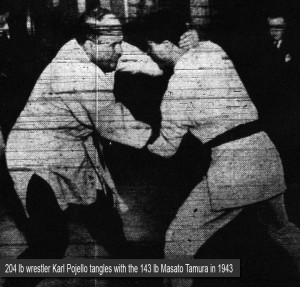
Writer Ismael Reed has said that every war is a war between churches. Churches are, if anything, institutions of belief. Many of our conflicts are often fueled by our belief systems. Americans pride themselves on their “values” with a missionary zeal.
That was what was at work on Feb 22nd, 1943, when the 143 lb American born Jiu Jitsu master Masato Tamura met the 204 lb wrestler Karl Pojello in an undisclosed location in Chicago under the watchful eye of the press, members of the military and Avery Brundage from the Olympic Committee. Pojello bragged he could beat any Jiu Jitsu expert in the world. He wanted to show Western superiority over Asian fighting skills. So he quickly got hold of someone 60 lbs lighter and a foot shorter than him, Masato Tamura. Read the news paper article for the good stuff.
Masato beat the bigger man in 1 minute and 20 seconds. I guess that is why Gene LeBell would ride a freight train boxcar from California to take lessons with this man. The country was at war. 800 people had been lost at sea due to German submarines several days before this match.
But Masato was American born and wanted to help. He was no member of the Japanese Black Dragon Society, an organization that was very active in Chicago and St. Louis at the time.
Karl Pojello, older, cocky and heavier was clearly out wrestled. Masato was forced to take further punishment even after his instant victory and Pojello was clearly trying to punish him for the idea of being defeated by a little “Jap.”
The military learned a valuable lesson that day. Martial Arts like Judo were just not for sport, they were clearly skills that were combat ready. Films like Behind The Rising Sun might have been good for public morale, but the fight scene with a boxer defeating a Japanese martial artist was a bit too pat. It is easy to underestimate an enemy in media, but it sets a dangerous precedent to send young men to war not prepared for the realities of their opponents proven man to man fighting skills.
Masato Tamura, at a time when his country was sending his cousins and friends to camps on the West Coast and him being subjected to this kind of abuse was clearly a heroic figure as he used Pojello as the whipping boy to make it clear to the military that Japanese martial arts were a essential skill for members of the US forces.
So what’s all this got to do with John Timothy Keehan? Well I figure he was about 4 years old and he heard about this as he grew up in the midst of the anti-Japaneses hysteria that lasted until the early 50s. Masato Tamura must have been legend after that 2 page spread in the Chicago Times.
Plus, I think this is a cool story to tell. People like Mas Tamura should never be forgotten.

Very cool– after your first post on the match I had wondered who won. Keep it coming Floyd!